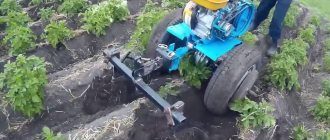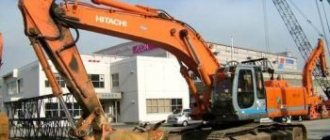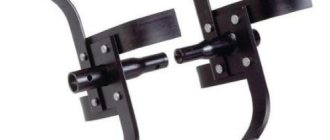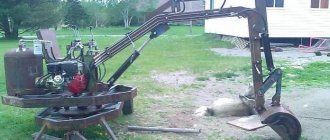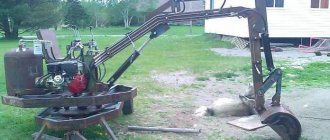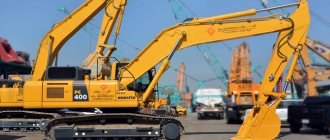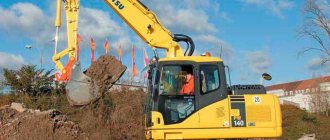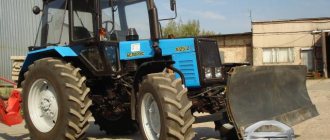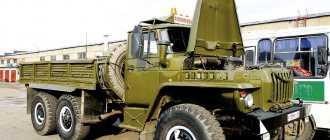Low-rise construction is increasingly developing. During the construction and development of the local area, the owner has to solve many small-scale tasks related to excavation work. Hiring special equipment for an hour or an hour and a half of work is not always possible and expensive.
The easiest way to solve the problem is to make a homemade excavator with your own hands. Having experience in building devices and mechanisms for the home, a small workshop, and equipment for working with metal, you can install a gas engine, power hydraulics and boom units of an excavator on a supporting trailed frame. As a result, an assistant will appear in your yard, capable of mechanizing many manual jobs.
History of origin
This special equipment began its history on the shores of Foggy Albion. In 1959, engineer and owner of the company of the same name, Richard Smalley, came up with the idea of placing excavator equipment on a trailer. He installed a gasoline engine and hydraulic drive system on a frame with two wheels, placed a seat on top, and attached a boom with a bucket and outrigger legs to it. This device quickly began to replace shovels, especially in funeral companies.
By the mid-60s of the last century, the equipment had a full-fledged operator’s cabin and a 360-degree rotation mechanism. It was the full-rotating Smalley 360, introduced in 1965, that received the title of the world's first trailed mini excavator.
With popularity in England came world fame. For two years - 1967 and 1968 - the company sold 150 Smalley 5 trailed mini excavators to Japan alone. They were already equipped with diesel engines and had a bucket volume of 5 cubic meters. ft (0.14 m3).
In general, the excavator trailer not only conquered its niche, but also became the basis for the further development and creation of mini equipment.
Description of the trailed excavator
Among the main areas where trailed mini-excavators are used, it is worth noting the following:
- clearing the area;
- soil treatment where large equipment is not suitable;
- creation of trenches and holes;
- laying communications;
- creating a pond or slide;
- loading crushed stone, soil and other bulk materials.
Typically, shovels were used for such work, except for digging a large hole for a pool or pond. But manual labor is quite hard and energy-consuming, so the shovel was replaced by an excavator running on a mini-tractor and having various attachments.
What is a trailed mini excavator?
The adjective trailed in the name of mini excavators indicates that this is a non-self-propelled vehicle. Its movement from one site to another is carried out using a vehicle. And unlike tracked excavators, these excavators do not require a trailer for transportation even by a passenger car. The base has wheels and can be towed by any vehicle. Although you can also use a standard trailer to transport it.
During operation, the trailed excavator must move around the work site. Due to the lack of propulsion, this procedure requires certain skills. The operator picks up the supports a little, moves the bucket forward and pulls the trailer with it. This can be done manually, but some models weigh more than two tons.
We are building a bucket - features of selection and installation.
The bucket is our workhorse. The direct load during excavation work falls on this important unit.
Buckets for mini excavators need to be made durable so that the equipment lasts long and efficiently. We make a bucket from two sides and a bottom using electric welding. During manufacturing, we will strengthen the bucket structure by welding stiffeners and fangs. We can make the teeth from the “fingers” from the tracks of old tractors .
You can also buy a ready-made ladle , but it’s not difficult to make it yourself, there are no complicated calculations, the choice is yours.
The choice of a mini excavator depends only on your desires and capabilities. If you have assessed your capabilities and decided to build your own mini excavator, you will get a lot of pleasure from the process and the results of your work. If your financial situation allows you to buy a new model, great, it will last a long time and be effective.
But for a technically creative person, the real pleasure will still be to create your own model. It is important here that the results of your work do not fade after calculating the costs of construction. If you are not confident in your strengths and skills, your mini excavator may cost you more than buying a ready-made one .
Areas of use
The main purpose of mini excavators is to perform small-volume work. In addition, they are great for working in confined spaces or hard-to-reach areas where large and heavy equipment is difficult to transport.
The main areas of application are:
- work in confined spaces - inside buildings, in mines, tunnels, pits;
- digging holes and trenches, incl. when repairing or laying communications;
- landscaping work, digging artificial reservoirs;
- excavation work on soft soils;
- work on a personal plot;
- landscaping.
The small footprint of trailed excavators allows them to be used for work on roadways and highways, without blocking traffic. As a result, they are in demand for installing road signs and fences.
With their help, the problems of landscaping courtyards and planting trees are solved. Often this technique is used in demolition work of buildings, mainly one-story buildings and interfloor walls or ceilings.
Excavators on trailers are also in demand for the forestry industry. For small volumes of dead wood removal, their use is more economically justified than the use of CMU.
As with conventional mini excavators, trailers can be equipped with not only buckets, but also other attachments. This also expands the applications of the machines. Among the most popular attachments are a drill, a hydraulic hammer, and a clamshell grab.
Drive – which is better and how to choose.
Having scoured the Internet and talked on forums, you will see a strong tendency for our homemade craftsmen to use a diesel drive for hydraulics when choosing. Industrial models also use diesel . In self-manufacturing, it is cheaper to use the Chinese Lifan engine. You can, of course, experiment with domestic engines, but it depends on your skills.
A mini excavator is a reliable assistant in excavation work; it is compact and convenient, but not without its drawbacks. The first of the disadvantages is the low speed, this equipment is not very mobile, and the digging depth is small due to the size of the mini excavator. But for small construction projects this technique is quite suitable.
Design features
The design of a trailed mini excavator is a supporting frame on which an engine for operating the mechanisms, a hydraulic system, a slewing bearing (for full-rotary models), a wheelbase of two or four wheels and attachments - a boom with a bucket - are installed.
note
, the stability of the equipment is ensured by outriggers and wheels.
Trailed excavators come in three types:
- with the rotation of the boom mounted on a rigid frame;
- with a full-rotating mechanism that allows you to rotate the platform 360 degrees;
- installed on a trailer.
Some experts also include mounted excavators mounted on tractors. They are separate attachments powered by the power take-off shaft (PTO). However, it is incorrect to consider them trailed, since they can work integrally with the base machine.
The main difference between trailed mini-excavators and self-propelled models is that they are easier to move from one site to another. If necessary, the trailer is hitched to a car, truck, tractor, or even an ATV and transported to another location.
Technical characteristics of the trailed excavator
The trailed excavator has the following technical parameters:
- two- or four-knee chassis;
- working supports that are extended manually or hydraulically;
- clutch, the type of which differs on one model or another.
Several types of such equipment are produced in Russia, each of which has its own users. We can distinguish the following groups of mini-tractor manufacturers.
Excavators that are equipped with a boom rotation mechanism. The tractor stands on a rigid frame, has 2 wheels and 2 supports. According to consumer reviews, high-quality mini-tractors are produced by Landformer, whose representative office is located in Zelenograd. The peculiarity of such mini-tractors is that the buyer must independently assemble all the parts and connect them together. The excavators are equipped with a single-cylinder engine with a power of 15 hp. The engine can be changed to a stronger one that runs on gasoline and diesel fuel.
An excavator on a trailer has different bucket sizes. There are buckets on sale, the width of which is 22, 35 and 60 cm. The Landformer excavator can be used for earthmoving or water purification work, for which the tractor is immersed on floating supports, and the attachments necessary for cleaning ponds are completely changed on it.
Powerfab mini-excavators are brought to Russia disassembled. At factories they are assembled separately, which takes a little time. The mounted mini-excavator, manufactured by the British company of the same name, has a powerful engine. This can be either a Honda GX-340 gasoline engine with a power of 9 hp, or a Honda GD-410 gasoline engine with a power of 10 hp. The package includes a set of buckets of different widths and capacities and a four-wheeled undercarriage. Separately, it is possible to install fenders to protect the car from dirt. The productivity of this model of tractor, which works with a trailer, is from 6 to 8 m³ per hour.
A separate group includes the Russian-made Scorpio trailed mini-excavator. Reviews from users of this equipment indicate that the mini-excavator is fully adapted to the conditions of domestic roads and soil. This allows it to be used almost everywhere: in the city, within rural settlements, in the country.
Buyers can choose the technical parameters and performance of the machine. First of all, this concerns engines, the number of axles and attachments.
Scorpio's advantage is the use of a reinforced arrow. The engines can be either gasoline from the Honda brand (9 hp) or diesel from ZS. Both engines have the ability to reach soil with a productivity of 8 m³/hour.
Buyers can choose how many wheels they want to install on the tractor. Typically these are 2 wheels and 2 supports, or 2 wheels and hydraulic cylinders for supports. Although quite often users choose another, more stable option: 4 wheels and 4 supports, which are lowered and raised using hydraulics. Engine power varies from 9 to 15 hp. You can also purchase: a standard trapezoidal bucket, a special hook that helps grab logs and stones, as well as a leveling bucket for large volumes of work. The Scorpio excavator is available with a special set of tools and parts for replacement. Service centers are open throughout the country to service mini-excavators.
There are also other manufacturers, in particular, Belarusian equipment deserves attention.



